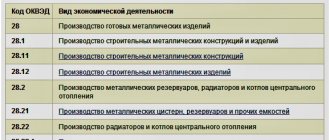What are OKVED codes and what are they intended for?
The abbreviation OKVED stands for All-Russian Classifier of Types of Economic Activities.
OKVED is a collection of statistical codes assigned to the types of activities that business entities are allowed to conduct in our country for the purpose of making a profit. In 2020, only one edition of the classifier is relevant - OKVED-2 (or OK 029-2014 [NACE rev. 2]). Classifiers of earlier editions OKVED-1 (or OK 029-2001 [NACE rev. 1]) and OKVED-2007 (or OK 029-2007 [NACE rev. 1.1]) have ceased to be valid since the beginning of 2020.
Why are OKVED codes needed:
- Based on them, the Social Insurance Fund determines the tariff for individual entrepreneurs to calculate insurance premiums against industrial accidents and occupational diseases. To assign a tariff, organizations submit an application and a calculation certificate confirming their main type of activity.
- The codes are important for the ability to use a special tax regime - simplified tax system, unified agricultural tax, UTII, which, in turn, affects the amount of tax obligations and the volume of reporting forms submitted to controllers.
- The right to take advantage of reduced rates of insurance premiums for compulsory insurance depends on the selected OKVED codes and the share of income from the main activity. However, this year, for most categories of insurers, including individual entrepreneurs, the possibility of applying reduced rates has been abolished.
How do OKVED codes of different editions correspond to each other?
A comparative table of compliance of new OVKED codes for 2020 with old codes was developed by the Ministry of Economic Development. If you need to know how to compare old OKVED codes and new ones, then download this table in excel format.
Download the compliance table from the Federal Tax Service:
Comparative table OKVED (.xls)
To compare OKVEDs, find the old code in column “B” of the table. For example, the old code 52.43 “Retail sale of footwear and leather goods” now corresponds to the new code 47.72 “Retail sale of footwear and leather goods in specialized stores.” As you can see, in this example both the OKVED (code number) and its description have changed.
How codes for entrepreneurial activity are selected for individual entrepreneurs
So, OKVED codes for individual entrepreneurs in 2020 are selected from OKVED-2.
To begin with, a potential businessman determines the area in which he wants to work. For this purpose, the classifier contains 21 sections. The most popular sections among individual entrepreneurs are related to:
- with retail trade;
- repair and construction;
- household services;
- freight and passenger transportation;
- repair and tailoring, etc.
IMPORTANT! There are areas in which a sole proprietor is not entitled to operate due to current legal provisions. These are, for example, activities related to the production of alcohol, medicines, weapons and military equipment, pyrotechnic products, as well as space, security activities, etc. That is, OKVED codes for individual entrepreneurs in 2020 tied to these and some other areas of activity year are prohibited.
In each section of the OKVED-2 classifier there is a gradation into classes (two symbols), subclasses (three symbols), groups (four symbols), subgroups (five symbols) and then the type of activity is specified (six symbols). This is how the choice occurs from the general to the specific.
After the choice is made, the individual will have to go through the registration procedure as an individual entrepreneur, which we will discuss in more detail below.
OKVED codes: Section P. Education
This section includes:
– education both for schoolchildren and for preparation for various professions
In the Russian Federation, the following types of educational organizations are established that implement basic educational programs:
1) preschool educational organization - an educational organization that, as the main goal of its activities, carries out educational activities according to educational programs of preschool education, supervision and care for children;
2) general educational organization - an educational organization that carries out educational activities according to educational programs of primary general, basic general and (or) secondary general education as the main goal of its activities;
3) professional educational organization - an educational organization that carries out educational activities according to educational programs of secondary vocational education as the main goal of its activities;
4) educational organization of higher education - an educational organization that carries out educational activities according to educational programs of higher education and scientific activities as the main goal of its activities
In the Russian Federation, the following types of educational organizations are established that implement additional educational programs:
1) organization of additional education - an educational organization that carries out educational activities in additional general education programs as the main goal of its activities;
2) organization of additional professional education - an educational organization that carries out educational activities in additional professional programs as the main goal of its activities
This section includes:
— state, municipal, non-state (private) educational organizations of all types
The system is multi-level: education for both adults and those who are learning the basics of literacy. Can be used in educational organizations implementing military professional educational programs, in educational organizations under the jurisdiction of the Federal Penitentiary Service
Each level has its own sets of programs
Separately included classes for students with disabilities
In the Russian Federation, education can be obtained:
— in organizations engaged in educational activities;
— outside of organizations engaged in educational activities (in the form of family education and self-education)
Training in organizations engaged in educational activities, taking into account the needs, capabilities of the individual and depending on the volume of compulsory activities of the teacher with students, is carried out in full-time, part-time or part-time form.
Education in the form of family education and self-education is carried out with the right to subsequently undergo intermediate and state final certification in organizations engaged in educational activities
A combination of various forms of education and forms of training is allowed
Forms of education and forms of training for the main educational program for each level of education, profession, specialty and area of training are determined by the relevant federal state educational standards, educational standards, unless otherwise established by this Federal Law of December 29, 2012 N 273-FZ “On education in the Russian Federation". Forms of training for additional educational programs and basic vocational training programs are determined by the organization carrying out educational activities independently, unless otherwise established by the legislation of the Russian Federation
Each level of education includes the activities of special (correctional) educational organizations (classes, groups) providing treatment, education and training, social adaptation and integration into society of children and adolescents with disabilities
This group classifies adult education whose content corresponds to certain levels of general education.
This section also includes:
— other types of education and training, for example training in driver’s schools;
- training mainly related to sports and recreational activities, such as tennis or golf, as well as educational activities received in general education organizations (school, boarding school, gymnasium, etc.), which is the basis for secondary vocational and higher education;
- secondary general education received at the same time (secondary music, dance, art schools, art schools, etc.)
How many OKVED codes can be specified when registering an individual entrepreneur
The future individual entrepreneur must fill out an application for registration of a citizen as an individual entrepreneur using form P21001. The types of activities that he intends to carry out are prescribed by OKVED codes in sheet A.
The entrepreneur needs to decide on the main direction of the business and write down its code in section 1 of sheet A. Section 2 includes additional codes - there can be as many of them as you like, the legislation does not limit the entrepreneur in this matter. That is, the individual entrepreneur has the right to indicate 1 code (this is the minimum), and then, if desired, it can be 5 codes, or 20, or 30... If all the desired codes do not fit on one sheet, several are filled in (clauses 2.16.2, 14.11 Requirements for the preparation of documents submitted by business entities during registration, approved by Order of the Federal Tax Service of Russia dated January 25, 2012 No. ММВ-7-6 / [email protected] ).
NOTE! The requirements for indicating OKVED are such that each code must consist of at least 4 digits. Thus, not only the class and subclass are specified, but also at least a group of activities. For example, if an entrepreneur wants to engage in retail trade, then using OKVED codes he will register what exactly he intends to sell and how the trade will be carried out. For example, OKVED code 47.51 means that an individual entrepreneur will retail textile products in specialized stores, and 47.81 means that retail trade in food products, drinks and tobacco products will be carried out in non-stationary retail outlets and markets.
Correct and incorrect code choice: consequences
When opening his own business, an individual entrepreneur (or the founder of a company) himself determines what type of activity he will engage in and finds its code in the classifier. By the way:
A company can have several types of activities. Their number is not limited, but one of them must be fixed as the main one.
The names of activities and their codes are contained in the company's Charter. They must also be reflected in the application for state registration.
When registering an enterprise, there is no need to try to document all possible types of its activities. This can be done later. The entrepreneur’s task at the initial stage is to determine which types will be the main ones and assign them codes, and the most suitable ones!
Why is code selection so important?
- 1.
It is on the basis of the code determined by the field of activity that the organization is assigned a number in the OKPO (classifier of enterprises). OKVED determines the industry affiliation of the company. - 2.
It must be remembered that certain types of activities should not be carried out by commercial organizations. In some cases, their implementation is allowed, but with restrictions. - 3.
Some areas require licensing. - 4.
Not all commercial activities can be carried out by individual entrepreneurs. - 5.
In some cases, there are restrictions on the minimum amount of authorized capital. - 6.
And most importantly: the chosen code has a direct impact on the amount of tax and off-budget deductions. Thus, the Federal Tax Service and the Social Insurance Fund have increased requirements for the most promising areas of business at the moment.
If the encoding is chosen incorrectly, the company will be forced to spend more money. However, an entrepreneur who wants to save money is not recommended to choose a more “affordable” (in terms of mandatory deductions) type of activity that he is not actually going to engage in - this is punishable.
Is it possible to make changes to OKVED IP - addition, change
Often, in the process of doing business, an entrepreneur begins to realize that some direction has become uninteresting to him, for example, due to its unprofitability, and some, on the contrary, he is ready to try in order to get maximum profit. To do this, you will need to close one type of activity and open a new one. Is it possible to do this?
Yes, it's possible. An entrepreneur can repurpose his business at any time.
However, the following question arises: what to do if, during registration, the entrepreneur did not declare the required code that determines his new direction? In this case, you need to add the OKVED code for the individual entrepreneur. We'll talk about how to do this correctly in the next section.
OKVED code structure
The classifier code consists of two to six digital characters and its structure can be presented as follows:
- XX - class
- ХХ.Х - subclass
- XX.XX - group
- XX.XX.X - subgroup
- XX.XX.XX – type
In applications for registration of an LLC or individual entrepreneur, it is necessary to indicate a minimum of 4 characters of the code; codes with two and three characters in applications are not acceptable.
Size - 4 MB.
How to add OKVED for individual entrepreneurs to registration documents
An individual entrepreneur adds OKVED by submitting an application to amend the information about an individual entrepreneur contained in the Unified State Register of Individual Entrepreneurs, according to form P24001. In this application, in addition to the mandatory title page and sheet G, page 1 of sheet E is filled out, which contains the codes to be included in the Unified State Register of Individual Entrepreneurs.
When changing the OKVED ID of an individual entrepreneur, you will need to fill out not only page 1 of sheet E, but also page 2. It reflects the codes that the businessman asks to be excluded from the Unified State Register of Entrepreneurs.
You do not need to fill out the remaining sheets of the form if nothing else changes.
The application must be printed and the pages numbered. Then the last name, first name, and patronymic of the businessman are manually written down on sheet F. The document is signed only at the time of its submission (if it is presented to the registration authority in person) - this should not be done in advance.
Learn about the order in which organizations change and add new activities in this article .
Results
When starting a business, an entrepreneur usually assumes what he will do. Each area of his business must be recorded in the Unified State Register of Individual Entrepreneurs using OKVED codes. Their choice must be approached with all seriousness, because they will influence the rate of insurance premiums for accidents and occupational diseases, the possibility of using one or another special regime, the volume of reports submitted, etc.
If a businessman wants to repurpose his activity, he has the right to report the addition or replacement of codes to the registration authority at any time.
You can find more complete information on the topic in ConsultantPlus. Full and free access to the system for 2 days.







